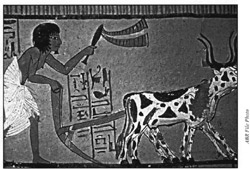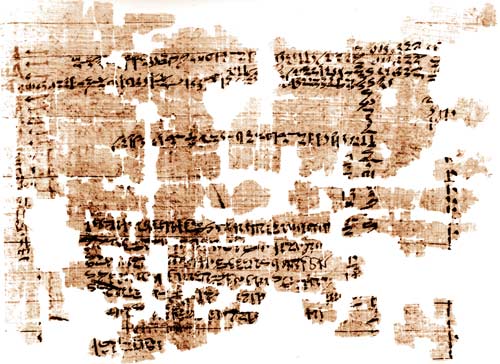
This article is the second in a series of six parts published in Bible and Spade.
Joseph began life in Egypt as a slave (Gn 39:1). As we saw in Part I of this study, these events in the life of Joseph should be dated to the great Middle Kingdom period of Egyptian history (2000–1782 BC).
It is important to note that during the Middle Kingdom, slavery as an institution of society flourished in Egypt, Evidence from Egyptian texts, indicates that at this time in Egypt’s history, the number of Syro-Palestinian slaves in bondage in the Nile Valley was growing constantly (Aling 1981:30, note 14). While some of these Asiatic slaves must have been prisoners of war captured by the Egyptian army in raids to the north, the majority certainly was not obtained by violence (Aling: 30). Most of the slaves were female; prisoners of war would have been predominantly male. Also, there are no Egyptian records of any major wars being fought by Egypt in Syria-Palestine in the Middle Kingdom. It is best to conclude that most of the Asiatic slaves entered Egypt just as Joseph did, through the slave trade. This, however, brings up an interesting question: why is there no written evidence at all of a slave trade between Syria-Palestine and Egypt?

“The Egyptians...worked them ruthlessly. The made their lives bitter... with all kinds of work in the fields.” (Ex 1:12–13). A plowing scene from the Tomb of Sennutem, Thebes, Egypt, 18th Dynasty.
First, let it be said that dismissing something on the basis of a lack of evidence is a dangerous business. Today, we have very few of the written documents composed in the Ancient Near East. What we have reflects accidental preservation. And, when we realize that the slave trade would have centered in the Nile Delta (northern Egypt), accidental preservation becomes even less likely due to the high water table there. Very few papyrus documents have been recovered from that region, especially from the earlier periods of Egyptian history. Also, the slave trade would have been in all probability in private hands rather than under government control. This would have made preservation of documentary evidence even more remote. Lastly, it is very possible that the slave trade would have been in the hands of foreigners rather than Egyptians, as the Bible implies in the case of Joseph. Records in so far as they were kept at all, would thus no be kept by Egyptians but by the Asiatics who were selling other Asiatic men and women to the Egyptians.

The Hieratic Papyrus dating from the late 12th Dynasty to 13th Dynasty. This papyrus contains 95 entries of slave names, of which 30 can be identified as non-Egyptian. Several non-Egyptian names are either identical to or very similar to some names in the Old Testament. In this Papyrus published by Hayes, we have evidence that officials of wealth and standing also could own slaves. The Potiphar of Genesis must have been such a man.
We are fortunate to have a papyrus from the Middle Kingdom that deals with slaves. This papyrus was studied and published some years ago by the American Egyptologist William C. Hayes (Hayes 1972). We will have occasion to refer to this remarkable document in the next issue of Bible and Spade, since the reverse side of this same papyrus contains a discussion of Egyptian prisons, another topic of vital importance for the Joseph story. But this papyrus” main significance lies in its list of Middle Kingdom slaves with names, nationality and titles or jobs held by these slaves. The list contains 95 entries. Of the 95 slaves listed, about 30 can be identified as non-Egyptian, either by their non-Egyptian names or by the designation “name”, meaning an Asiatic (Hayes: 92).
Two things of great interest emerge from a study of the Asiatic slaves on this list. First, the names are very significant to the student of the Bible. Several of them are either identical to or very similar to some names familiar to us from the Old Testament itself. A female version of the Hebrew name Menahem is present; Sk-ra-tw, also the name of a woman, is paralleled by the Hebrew name Issachar; Ashra is most certainly the feminine version of Usher; and Shepra is known to us in the Old Testament as Shiphrah, the Hebrew midwife in the Book of Exodus (Hayes: 95–96). Secondly, the duties assigned to the Asiatic slaves in our list provide some important correlations to Joseph’s career. The kinds of jobs performed by the Asiatic slaves are generally less onerous than those assigned to native Egyptian slaves, and are in fact classifiable as skilled labor (Hayes: 93). Let us examine some of the titles held by the Asiatic slaves.

A vineyard scene from the Tomb of Apy, Thebes, 19th Dynasty The Israelites would have had to work harvesting grapes and making wine as in this scene from ancient Egypt.
One of the most common titles held by male Asiatic slaves was that of “Household Servant” (Hayes: 103 ff). This is not only a confirmation of the accuracy of Scripture, which assigns this title to Joseph, but also helps us to get a better idea of what kinds of work Joseph would have been involved in while a slave of Potiphar. When we examine Egyptian monuments that picture or discuss household servants, we find that such slaves performed the normal kinds of tasks we would expect. For example, they are often shown in tomb paintings bringing food and drink to their masters (Hayes: 104). An Asiatic slave could also be a cook, a teacher, or a brewer (Aling: 35).
A final fact to note from Hayes’ papyrus is that slaves in the Middle Kingdom were commonly owned by private individuals. It has always been known that the governments of the Near East were owners of large numbers of slaves, many of whom would have been used in the vast construction projects of the state such as temple building, palace repair, and the construction of fortifications. It may be assumed that slaves would also have been employed as laborers on both the large agricultural estates of the king and of the temples. But here, in the papyrus published by Hayes, we have evidence (p. 134) that officials of wealth and standing also could own slaves. The Potiphar of Genesis must have been such a man.

Joseph’s entire life and career were indeed remarkable. As the Bible repeats again and again, the Lord was with Joseph and blessed what he did. God’s blessing was, in fact, so obvious that Joseph’s Egyptian masters were able to recognize it! (Gn 39:3) We find in Genesis 39:4 that Potiphar, Joseph’s first Egyptian master, promoted Joseph from being merely a household servant to become his steward, the one over his household. What did this entail?
From the far better documented New Kingdom period of Egyptian history (1570–1085 BC). we have information on the duties of the steward (Aling: 35–36). Under Mery, the High Priest of the god Amon for King Amenhotep II, a man named Djehuty served as steward. Two of his subsidiary titles were “Scribe of Offerings” and “Chief of Agricultural slaves.” The first proves that he was literate, and the second shows us his primary duty, the supervision of his master’s agricultural estates. Several other stewards known from New Kingdom times had the same titles. This indicates two things about Joseph. First, he was literate. He would have to be to hold a stewardship. How and when he learned to read and write the complex Egyptian language is not known. Perhaps it was when he was a household servant of Potiphar. In any case, we may assume that Joseph was a quick and diligent student. Secondly, as a steward, Joseph would have been in charge of the agricultural holdings of his master, Potiphar. We should remember that ancient Egypt did not have a money economy as we know it today, and officials such as Potiphar would have been paid for their work by being allowed the use or ownership of farmlands. Potiphar would not have the time or perhaps even the skills to supervise the land and its cultivation himself; hence the necessity for a steward. We remember too that Joseph came from an agricultural family, and presumably already had extensive knowledge of farming techniques and farm animals.

“By the sweat of your face you shall eat bread” (Gn 3:19). Egyptians harvesting wheat, from the Tomb of Menna, Thebes, 18th Dynasty.
From a practical point of view, there are two reasons why it is important for the modern student of the Bible to realize all this about Joseph. First, through a knowledge of what an Egyptian steward did, we can see the accuracy of the book of Genesis, even in minute details. Note for example Genesis 39:5. At the end of this verse, we are told that Potiphar’s holdings were blessed for Joseph’s sake, both in the house and in the field. When we understand that Joseph was a steward, and when we learn what kinds of things a steward did in both the house and the field, we have a far clearer appreciation of this verse and what it is telling us. Second, when we see that Joseph was an Egyptian steward, we see him getting the kind of on-the-job training he would need for the ultimate task God had for him, the task of preserving the people of Israel during the coming time of great famine. As we will see in a later article, Joseph will eventually become the head of agriculture for the entire land of Egypt. Under Potiphar, he received vital experience on a smaller scale for the far greater responsibility he will have later. He was faithful over a small job; God would therefore give him a more important one (Lk 16:10).
In our next article, we will find Joseph in prison. This same papyrus published by Hayes will give us much information on this aspect of the life of Joseph.
Reprinted in Bible and Spade with permission from Artifax 15.4 (Fall 2000).
Bibliography
Aling, C. F.
1981 Egypt and Bible History. Grand Rapids: Baker Book House.
Hayes, W. C, ed.
1972 A Papyrus of the Late Middle Kingdom in the Brooklyn Museum. Brooklyn: Brooklyn Museum Reprint.